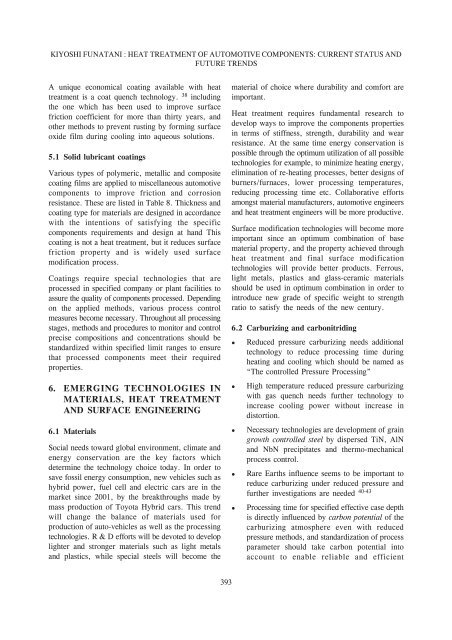HEAT TREATMENT OF AUTOMOTIVE COMPONENTS: CURRENT ...
HEAT TREATMENT OF AUTOMOTIVE COMPONENTS: CURRENT ...
HEAT TREATMENT OF AUTOMOTIVE COMPONENTS: CURRENT ...
You also want an ePaper? Increase the reach of your titles
YUMPU automatically turns print PDFs into web optimized ePapers that Google loves.
KIYOSHI FUNATANI : <strong>HEAT</strong> <strong>TREATMENT</strong> <strong>OF</strong> <strong>AUTOMOTIVE</strong> <strong>COMPONENTS</strong>: <strong>CURRENT</strong> STATUS AND<br />
FUTURE TRENDS<br />
A unique economical coating available with heat<br />
treatment is a coat quench technology. 38 including<br />
the one which has been used to improve surface<br />
friction coefficient for more than thirty years, and<br />
other methods to prevent rusting by forming surface<br />
oxide film during cooling into aqueous solutions.<br />
5.1 Solid lubricant coatings<br />
Various types of polymeric, metallic and composite<br />
coating films are applied to miscellaneous automotive<br />
components to improve friction and corrosion<br />
resistance. These are listed in Table 8. Thickness and<br />
coating type for materials are designed in accordance<br />
with the intentions of satisfying the specific<br />
components requirements and design at hand This<br />
coating is not a heat treatment, but it reduces surface<br />
friction property and is widely used surface<br />
modification process.<br />
Coatings require special technologies that are<br />
processed in specified company or plant facilities to<br />
assure the quality of components processed. Depending<br />
on the applied methods, various process control<br />
measures become necessary. Throughout all processing<br />
stages, methods and procedures to monitor and control<br />
precise compositions and concentrations should be<br />
standardized within specified limit ranges to ensure<br />
that processed components meet their required<br />
properties.<br />
6. EMERGING TECHNOLOGIES IN<br />
MATERIALS, <strong>HEAT</strong> <strong>TREATMENT</strong><br />
AND SURFACE ENGINEERING<br />
6.1 Materials<br />
Social needs toward global environment, climate and<br />
energy conservation are the key factors which<br />
determine the technology choice today. In order to<br />
save fossil energy consumption, new vehicles such as<br />
hybrid power, fuel cell and electric cars are in the<br />
market since 2001, by the breakthroughs made by<br />
mass production of Toyota Hybrid cars. This trend<br />
will change the balance of materials used for<br />
production of auto-vehicles as well as the processing<br />
technologies. R & D efforts will be devoted to develop<br />
lighter and stronger materials such as light metals<br />
and plastics, while special steels will become the<br />
material of choice where durability and comfort are<br />
important.<br />
Heat treatment requires fundamental research to<br />
develop ways to improve the components properties<br />
in terms of stiffness, strength, durability and wear<br />
resistance. At the same time energy conservation is<br />
possible through the optimum utilization of all possible<br />
technologies for example, to minimize heating energy,<br />
elimination of re-heating processes, better designs of<br />
burners/furnaces, lower processing temperatures,<br />
reducing processing time etc. Collaborative efforts<br />
amongst material manufacturers, automotive engineers<br />
and heat treatment engineers will be more productive.<br />
Surface modification technologies will become more<br />
important since an optimum combination of base<br />
material property, and the property achieved through<br />
heat treatment and final surface modification<br />
technologies will provide better products. Ferrous,<br />
light metals, plastics and glass-ceramic materials<br />
should be used in optimum combination in order to<br />
introduce new grade of specific weight to strength<br />
ratio to satisfy the needs of the new century.<br />
6.2 Carburizing and carbonitriding<br />
• Reduced pressure carburizing needs additional<br />
technology to reduce processing time during<br />
heating and cooling which should be named as<br />
“The controlled Pressure Processing”<br />
• High temperature reduced pressure carburizing<br />
with gas quench needs further technology to<br />
increase cooling power without increase in<br />
distortion.<br />
• Necessary technologies are development of grain<br />
growth controlled steel by dispersed TiN, AlN<br />
and NbN precipitates and thermo-mechanical<br />
process control.<br />
• Rare Earths influence seems to be important to<br />
reduce carburizing under reduced pressure and<br />
further investigations are needed 40-43<br />
• Processing time for specified effective case depth<br />
is directly influenced by carbon potential of the<br />
carburizing atmosphere even with reduced<br />
pressure methods, and standardization of process<br />
parameter should take carbon potential into<br />
account to enable reliable and efficient<br />
393
















